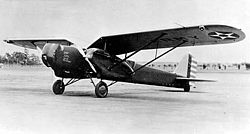Douglas XB-7
| Douglas XB-7 | |
|---|---|
 Douglas XB-7, prototype |
|
| Type: | light bomber |
| Design country: | |
| Manufacturer: | |
| Commissioning: |
not put into service |
| Production time: |
never mass-produced |
| Number of pieces: |
8th |
The Douglas XB-7 was the prototype of a light bomber made by the Douglas Aircraft Company in the early 1930s.
history
When the order was placed, the prototype still bore the designation XO-36 (serial number: 30-228). From the XO-35 (s / n 30-227) also commissioned by the US Army Air Corps at Douglas on March 26, 1930 , the XO-36 differed mainly in its smaller wingspan. The XO-36 was designed as a competitor to the Fokker YO-27 , which later led to the Fokker XB-8 . The two planes were so convincing that Douglas proposed to the Army Air Corps that the XO-36 be converted to a bomber. It was renamed XB-7 and got bomb holders for 540 kg bombs.
The XB-7 was faster than the previous Keystone B-6A bombers from Keystone Aircraft Corporation and far superior to them. The machine was delivered after a long trial in 1931 in Santa Monica, then in July 1932 to Wright Field. In August 1931, the Army Air Corps ordered seven Y1B-7 pre-production aircraft (32-308 through 32-314), which were delivered between August and November 1932. In contrast to the prototype, these aircraft had sheet metal planking.
Shortly after the handover of the Y1B-7 to the Air Corps, the aircraft, now designated as B-7, were stationed at March Field, California, for the 11th and 31st Bombardment Squadron. A machine was lost in a crash after 10 months. In early 1934, the remaining six B-7s were handed over to the Western Zone, where they were used for mail flights. These planes carried mail across western America, such as Cheyenne and Wyoming to the Pacific coast. On February 16, 1934 a machine (32-309) with Lt. James Eastmann in Jerome, Idaho when she got caught in a snow storm. The flights were operated by the Army Air Corps until June 1, 1934, when the last military aircraft was in service on the scheduled mail flight. Two machines flew until 1938/39.
Despite the positive test phase, the Y1B-7 never went into production, mainly because of its low bomb load. Instead, the Martin B-10 was mass-produced.
construction
The XB-7 was as high wing designed and had gull wing ( gull wings (gullwing)). The all-metal aircraft was completely clad with duralumin . The duralumin cladding was corrugated in order to increase the stability together with the gull wing. The crew of the XB-7 consisted of four men (pilot, copilot and two gunners, one in the aircraft bow and one in the rear fuselage).
Douglas provided two Curtiss Conqueror engines as propulsion , which were mounted with struts in nacelles under the wings. The gondolas were also braced to the hull. The main landing gear was pulled back into the engine cowling, with the lower wheel parts sticking out. Two movable 0.30 " machine guns were planned as defensive armament . Under the fuselage the machine could carry 544 kg bombs on suspensions. The Y1B-7 were powered by two 675 HP Conqueror engines. The machines had no corrugated iron cladding more and had been lengthened from 13.72 m to 14.0 m to improve the center of gravity. The tank capacity was increased to 439 liters, so that a flight time of around four hours was possible. Further changes were made during the field test, including one modified distribution system, improved engine monitoring and oil cooler, and improved equipment.
Military use
Technical specifications
| Parameter | Data of the Y1B-7 |
|---|---|
| length | 13.9 m |
| Wingspan | 19.9 m |
| Wing area | 57.71 m² |
| height | 3.7 m |
| drive | 2 × 12-cylinder V-engines Curtiss V-1570 -27 "Conqueror" each with 675 PS (504 kW) |
| Top speed | 293 km / h |
| Range | 1020 km |
| crew | 4th |
| Service ceiling | 6200 m |
| Empty mass | 2503 kg |
| normal starting mass | 4515 kg |
| Max. Takeoff mass | 5070 kg |
| Armament | 2 × 7.7 mm machine guns, 540 kg bombs |
See also
literature
- René J. Francillon: McDonnell Douglas Aircraft since 1920. Putnam, London 1979, ISBN 0-370-00050-1 .
- Alain J. Pelletier: Bombers as Postmen. Boeing Y1O-35 and Y1B-7. In: Air Enthusiast. No. 122, March / April 2006, ISSN 0143-5450 , pp. 30-40.
- Ray Wagner: American Combat Planes. Doubleday, New York 1982, ISBN 0-930083-17-2 .
Web links
- Factsheet Douglas Y1B-7 at the National Museum of the United States Air Force (English)

